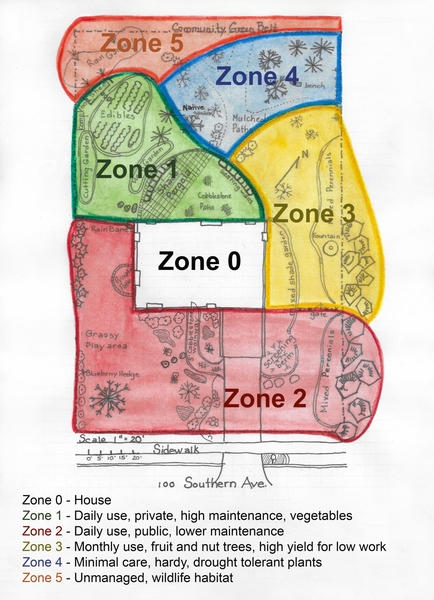Introduction
Permaculture was founded by Australians Bill Mollison and David Holmgren in the early 1970s. In their seminal book, Permaculture One (1981), they explain that permaculture melds permanent and agriculture, and is defined as "consciously designed landscapes which mimic the patterns and relationships found in nature, while yielding an abundance of food, fiber and energy for provision of local needs." The definition of permaculture has expanded to include people, communities and organizations, and so has evolved to permanent (or sustainable) culture.
Permaculture Is Grounded in Three Ethics
- Care for the earth. The discipline looks to nature as a model for design. Permaculture includes replicating and restoring natural systems. With this ethic, permaculture emphasizes organic and sustainable methods of working with the land. It promotes the use of naturally occurring and locally available materials for design, installation and maintenance.
- Care for people. One primary goal of permaculture is to provide for people’s basic needs, including food, shelter, human connection, education, and a sense of purpose and place. A permaculture designer aims to produce both food and pleasure.
- Share in the surplus. The third ethic is to share the surplus once basic needs are met. In alignment with natural systems, excess yield is transferred to another system or person. Waste becomes an asset to be repurposed.
Applying Permaculture Design Skills
Apply the following three tactics to design within a basic permaculture framework.
Tactic 1: Observe and interact with natural patterns
The first step in permaculture is to observe. The goal of permaculture is to learn from, and mimic, nature and natural systems. Take note of the natural systems that occur on your land. Pay attention to how and where water naturally runs and pools. Consider the ways people walk through the space because sometimes water or topography can dictate human paths. Notice where the site receives sun at different times of day. Be mindful of what types of trees are present, when and how they lose their leaves, and what you do with those leaves once they fall. All of this information is useful to understand existing assets and needs. Permaculture incorporates existing patterns and materials. For example, by observing how people navigate the space, you can locate pathways based on natural patterns. Noticing the amount of leaf fall in autumn and how quickly the leaves decompose allows you to consider leaves as an asset—a free, on-site mulch for any garden beds. Noticing sun location can help you create sunny outdoor rooms and understand where to place deciduous trees to allow passive solar heat in the colder months while blocking solar heat in the warmer seasons.
Tactic 2: Focus on energy efficiency
Mimic natural systems to decrease the human energy required to maintain a landscape. Choose and place elements to provide basic needs on-site and decrease the time, energy, and money spent acquiring the resources necessary to fuel a productive site.
Another tactic for energy-efficient planning is using a zone system based on how often tasks are performed (Figure G–1). Zone zero is the house itself. Zone 1 is closest to the house, and zones 2 through 5 are located increasingly further away.
Zone one includes the most intense activities that need to be performed several times a day and related elements that need to be accessed quickly. Examples include compost containers for kitchen scraps and kitchen herb gardens. Place a kitchen herb garden as close to the kitchen entrance as possible to facilitate leaving the kitchen while cooking, cutting some herbs, and returning to the stove quickly. Zone two includes activities that need to be performed about once a day. Zone three involves things that happen several times a week. Zone four includes activities that happen monthly or seasonally, such as harvesting building materials or foraging seasonal wild foods. Zone five is an area that is not managed at all, but is a place to observe and learn from nature.
Table G–1. Each zone and its recommended activities.
| Average frequency of visits | Some appropriate elements | |
|---|---|---|
| Zone 1 | Multiple times each day | Kitchen/herb garden, potted plants, chickens |
| Zone 2 | Daily | Vegetable gardens, chickens, early blooming fruit trees, trash containers, kitchen compost, cold frames |
| Zone 3 | Weekly | Fruit orchard, perennial shrubs |
| Zone 4 | Visited monthly/seasonally | Mushrooms, cane harvesting, long-term compost, woodland foraging, nut tree crops |
| Zone 5 | Visited to observe & learn | Nature/Wilderness/Mature forests |
Note that some activities may need to be placed in different zones for different users. Also note that zones often are shown as concentric circles. This may not always be the case, depending on the site (Figure G–2).
Zone 0 – House
Zone 1 – Daily use, private, high maintenance, vegetables
Zone 2 – Daily use, public, lower maintenance
Zone 3 – Monthly use, fruit and nut trees, high yield for low work
Zone 4 – Minimal care, hardy, drought tolerant plants
Zone 5 – Unmanaged, wildlife habitat
Tactic 3: Use permaculture principles as a guide to mimic nature
There is not one single list of principles. Rather, each practitioner has created a set of principles, very similar in concept, but with slight differences in focus. The principles delineated below are based on the principles stated by Bill Mollison in Introduction to Permaculture (1997), David Holmgren in Principles and Pathways Beyond Sustainability (2002), and well-known North American permaculturalist and author of Gaia’s Garden, Toby Hemenway (2009). Permaculture designers strive to incorporate each of the principles described below. Included are explanations and examples of ways to apply permaculture principles as elements or techniques.
Permaculture Principles
1.Observe and Interact
Learn to recognize natural patterns and relationships. Continual thoughtful observation is the key to good design. It is ideal, although not always possible, to observe a site in all four seasons before making design decisions about the space. When long-term observation is not an option, tools and calculations are available to assess the presence of sun and shade in various seasons, average monthly rainfall, first and last frost dates, and other data. Keep a garden journal to record weather, actions in the garden, and observations. Begin to recognize patterns and relationships between events such as temperature variations and disease, drought stress and insect problems, and day length and flowering.
2. Catch, Store, and Cycle Energy
Catch natural energy and use it as many times as possible within the site. Natural energies include sun, wind, water, and many natural cycles that we can work with and within to lessen the human energy necessary to maintain a landscape. Harnessing or catching the energy at its highest level is the first step. For example, installing berms and swales throughout the landscape ensures that rainwater is slowed and sinks into the earth as a natural reservoir rather than running off. Another example is to use tall cisterns that reach up to the roof to capture rainwater and that have outlets high enough that gravity can be used for distribution. We can also use a solar pathfinder to identify how much sun is available on a site during different seasons and where best to site and install solar panels.
Storing this energy is crucial to a site’s long-term sustainability. Catchment containers and batteries must be big enough to capture the energy available. There are several rainwater catchment calculators available online. Similar calculations can and should be done with solar energy.
The final step is to cycle the energy. Once you have captured energy, use it in as many different ways as possible before it becomes a waste product or is cycled offsite. One example of energy cycling might be multiple uses of water. Catch water in a pond at the top of a slope. Use the pond as habitat for wildlife, a source of irrigation water in the heat of the growing season, and for soaking mushroom logs. When the water needs to be cycled out, drain the pond using gravity and have the soil catch that water to supply plants in drought. You have caught water on the site and used it in at least four different ways before it leaves the site. This is energy efficient cycling.
3. Relative Location
Identify which elements are connected, and place them accordingly. When we place related elements together, we reduce the human energy needed to complete tasks. Using the zone system helps with placement. One example of relative location is the placement of chickens, water, and compost in the landscape. Chickens need water, and they are very useful in breaking down a compost pile. Free-ranging chickens will gravitate toward the compost pile as a preferred hangout. Also, the material collected from a chicken coop, when cleaned, will likely add material to the compost pile. These elements benefit one another, and their proximity makes our management of each element less intensive.
4. Stack Functions
Each element supports many different tasks and needs. Create elements that serve many different purposes, making the most efficient use of the materials and space used. A Belgian fence (Figure G–3) is one example of an element that stacks functions. The fence, made from grafted fruit trees, acts as a space divider as well as a food source. A an apple tree is a productive specimen in a garden, especially in the South. A fig tree placed at the north side of a vegetable garden in proximity to a house or work shed, and pruned around a ladder or tree house, becomes more than a source of food, It is also a climbing gym for children, a shade source in the summer, an easily managed harvest using the built-in platform, and wattle fence material from winter pruning. In this vein, think about placement and plant choice to optimize the number of different functions one element can play.
5. Stock the Most Important Functions
The most important needs in a site are supplied by multiple elements. Include backups in the system, alternate sources for important inputs, especially for the most important elements. For annual vegetables, have multiple sources of water collection and storage: in ponds, in cisterns, and in the soil. For soil, have multiple ways to continuously add nutrients and build soil: compost on site, grow and mulch with cover crops, and rotate crops.
6. Use and Value Diversity
Within the site, place importance on having many different species and elements. A diversity of crops allows for resilience in a landscape and helps to support a more dynamic ecosystem including both beneficial and pest animals, insects, and plants. Consider including different varieties of the same plant as well as including many different types of plants: annuals, perennials, edibles, and pollinator plants. This will offer the landscape resilience against disease organisms and pests, and it will create a more interesting look and feel.
7. Optimize Edges and Value the Marginal
Notice, learn from, and use the complexity that exists at the edges. In nature, the richest ecosystems occur where two different bioregions meet. The soil where the forest and the field meet is dense with minerals and leaf mulch, including the area is an excellent mixture of sun and shade, and there is animal activity from both the field and the forest. Look for and create these types of edges in the landscape by creating curves and using plants as borders. The keyhole garden (Figure G–4) is a good example of increasing the edge in a landscape. Creating gardens in a keyhole shape increases the number of different types of plants that adjoin one another. A keyhole shape also creates an efficient use of space where many plants can be tended from one location.
Similarly, value what are often considered marginal plants and animals. This may require reconsidering what is identified as a “weed.” For example a dandelion is an early succession plant that reveals where soil needs care, a plant that is actively restoring poor soil by pulling up minerals from deep in the ground with its taproot, a wild green that we can harvest before it flowers, and a mineral-rich green naturally occurring in our landscape.
8. Use Small and Slow Solutions
Test new ideas on a small scale. Become comfortable and knowledgeable before expanding. Permaculture encourages us to use small tools and processes that may be slower, but make us conscious of local sourcing for materials. Some examples of small and slow alternatives include digging garden beds by hand rather than tilling soil, building with natural materials like cob or straw bale rather than synthetic materials with a bigger ecological footprint, and using a broad fork to turn soil rather than till each season. Another example would be building a small pond to understand how to site, install, and maintain the system before digging a large pond that does not drain or cycle.
9. Creatively Use and Respond to Change
Learn from and apply cycles as symbols of constant change, as in nature. Expect change to happen. Design and manage from this mindset. Nature is in constant flux—growing, dying, and rebuilding all of the time. This process can be referred to as succession. Work to facilitate succession in a space, transitioning a grassy lawn into a multi-story food forest in a matter of a few years through tactics such as sheet mulching, cover cropping, and planting in several different stories. Start with a ground floor, and slowly add taller and larger plants as the initial story matures. Factor in the succession of a space to create systems that work for seedlings as well as mature trees, shrubs, and understory plantings. Consider the change of seasons in the design, and create spaces and make plant choices that allow for year-round harvest and interest. Also consider the unexpected changes that nature presents, such as unexpected amounts of heat, cold, wind, and water. Build landscapes that are flexible, and be open to transitioning a design over time. As noted in the sixth principle, building in a diversity of plants creates resilience that can withstand sudden changes more readily than a landscape that includes very few types of plants and wildlife.
10. Produce No Waste (or Create Closed Loops)
Much of the work of permaculture, especially in an urban setting, is to identify and create uses for what are usually considered waste products. When we observe the landscape and day-to-day activities, we see a lot of waste (paper cups, coffee grounds, and yard clippings). Some examples of using waste in the landscape include collecting leaves in the fall and using them as mulch, connecting with the local coffee shop to collect spent coffee grounds for use in the garden, and considering garden pruning as a resource for mulch and compost rather than yard waste. Fruit tree pruning can be used to create wattle fences. If plant selection is done well, many green cuttings of plants trimmed in the garden can be placed directly onto other beds as mineral-rich mulch (dynamic accumulators). Enrich the system and lower costs by re-imagining so-called waste products as resources available for other systems and needs in the landscape. For example, weeds and caterpillars are chicken food, and chicken feces can be composted into fertilizer.
11. Design Interconnections Among Elements
Permaculture is more about connections within a system than about the individual elements within that system. Support each element (for example, a pond, a bee hive, mushroom logs, or chickens) with related elements, and understand how one element is needed as well as supported by other elements. This is the true application of permaculture, and the key to creating landscapes that are more self-sufficient, resilient, and continuously productive. An example of this on a small scale is a fruit tree guild (Figure G–5 and Figure G–6). In a fruit tree guild, when a tree is planted, several other plants are planted around the base of that tree. Each of the plants is chosen and placed intentionally for its ability to support the tree and surrounding plants in some way. A guild might include a productive fruit tree, a mulching plant, a plant whose roots slow erosion and hold soil, a plant that attracts beneficial insects, and a plant to block the wind.
Figure G–5 Reference:
A) Bee attractants: bee balm (Monarda spp.), borage (Borago officinalis)
B) Nitrogen fixers: clover, legumes
C) Bulbs to inhibit grass: garlic, onions, daffodils (Narcissus spp.)
D) Pest repellent herbs: mint (Mentha spp.), oregano (Origanum vulgare), lavender (Lavandula spp.)
E. Human attractants: berries
F) Dynamic accumulator, mulch plant comfrey (Symphytum spp.)
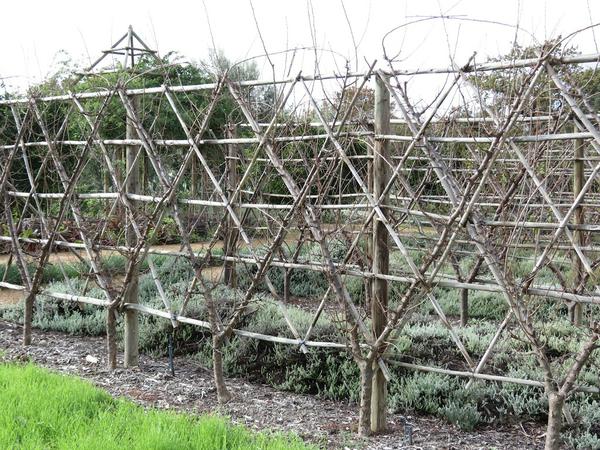
Figure G–3. A Belgian fence is espaliered fruit trees in a diamond pattern. This fence not only helps define the garden but also provides fruit.
Malcolm Manners, Flickr CC BY 2.0
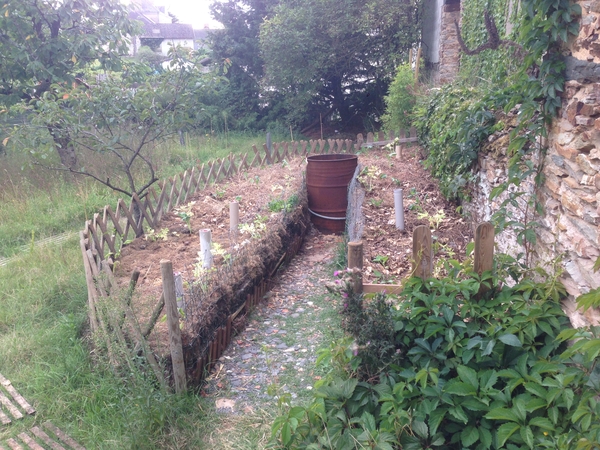
Figure G–4. Keyholes allow the gardener to access many parts of the bed from a single location.
VLCinéaste, Flickr CC BY 2.0
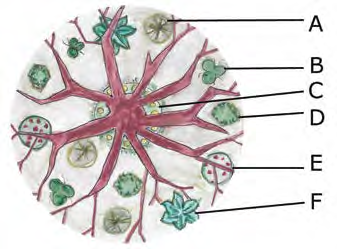
Figure G–5. A fruit tree guild showing plants that can be placed around the base of the tree to support it in some way.
Kathleen Moore CC BY 2.0
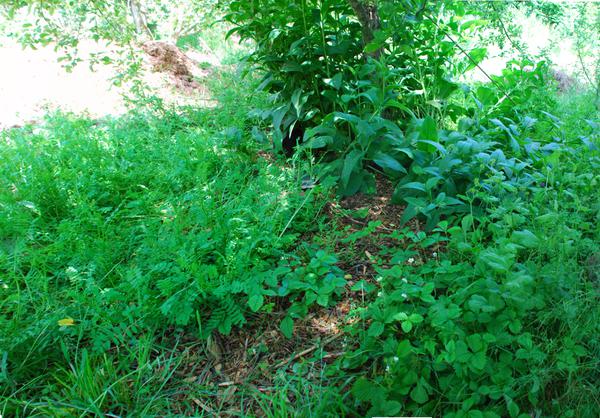
Figure G–6. An apple tree guild with pollinator attracting crown vetch (Securigera varia), a dynamic accumulator comfrey (Symphytum spp.), and human attracting strawberries planted below.
yaquina, Flickr CC BY 2.0
Conclusion
In summary, permaculture is a mindful application of techniques for managing energies and resources, including wind, water, sun, soil, nutrients, animals, and people. Some energies are lacking and will need to be enhanced (which is often so for water). Other energies are in oversupply and may need to be mitigated or dispersed. Our ultimate goal in permaculture is to create connections among design elements so that the landscape is a cohesive and resilient system. Once principles are considered, work to ensure that principles and elements support and connect with one another.
Figure G–7 shows a garden made using multiple permaculture principles. If you are interested in more information, there are many books about permaculture as well as workshops and permaculture designer certification courses across the country.
If you have questions about this appendix contact your Extension agent at your local Cooperative Extension center.
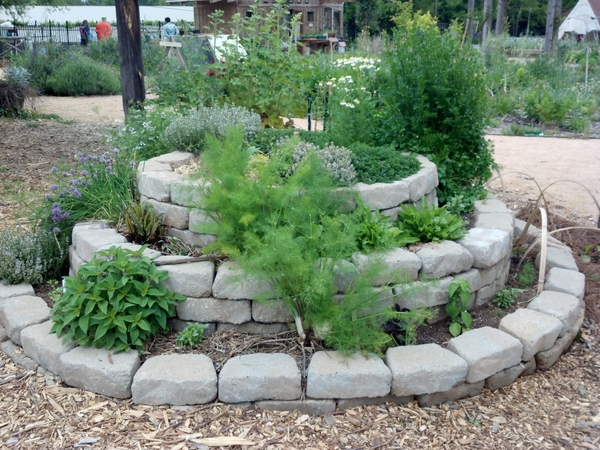
Figure G–7. A spiral herb garden takes advantage of rainfall allowing water to seep down to lower levels. It takes up less space than a traditional bed because it uses vertical space.
Lucy Bradley CC0
Publication date: Feb. 1, 2022
AG-831
Other Publications in North Carolina Extension Gardener Handbook
- 1. Soils & Plant Nutrients
- 2. Composting
- 3. Botany
- 4. Insects
- 5. Diseases and Disorders
- 6. Weeds
- 7. Diagnostics
- 8. Integrated Pest Management (IPM)
- 9. Lawns
- 10. Herbaceous Ornamentals
- 11. Woody Ornamentals
- 12. Native Plants
- 13. Propagation
- 14. Small Fruits
- 15. Tree Fruit and Nuts
- 16. Vegetable Gardening
- 17. Organic Gardening
- 18. Plants Grown in Containers
- 19. Landscape Design
- 20. Wildlife
- 21. Youth, Community, and Therapeutic Gardening
- Appendix A. Garden Journaling
- Appendix B. Pesticides and Pesticide Safety
- Appendix C. Diagnostic Tables
- Appendix D. Garden Tools
- Appendix E. Season Extenders and Greenhouses
- Appendix F. History of Landscape Design
- Appendix G. Permaculture Design
- Appendix H. Community Gardening Resources
- Appendix I. More NC State Resources
- Glossary
N.C. Cooperative Extension prohibits discrimination and harassment regardless of age, color, disability, family and marital status, gender identity, national origin, political beliefs, race, religion, sex (including pregnancy), sexual orientation and veteran status.


